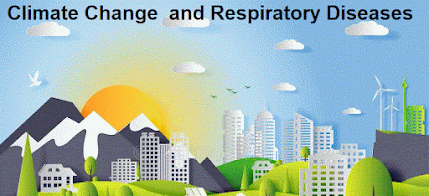Effects of Climate
Change on Respiratory Diseases
Climate change represents one of the most pressing global
challenges of the 21st century, influencing myriad aspects of human health.
Among the various health implications associated with climate change, the
exacerbation of respiratory diseases is particularly concerning. This essay
delves into the interplay between climate change and respiratory health,
exploring how environmental factors such as air quality, allergens, and extreme
weather events contribute to respiratory ailments.
One of the most significant impacts of climate change is the
deterioration of air quality primarily due to increased levels of air
pollutants. The burning of fossil fuels, a major contributor to greenhouse gas
emissions, releases particulate matter (PM), nitrogen oxides (NOx), and sulfur
dioxide (SO2) into the atmosphere. These pollutants can induce or worsen
respiratory conditions such as asthma and chronic obstructive pulmonary disease
(COPD). For instance, a study conducted in urban areas has shown that increased
concentrations of PM2.5 correlate with a rise in asthma attacks,
hospitalizations, and emergency room visits during high pollution days.
Moreover, climate change has been shown to affect the
distribution and prevalence of allergens, which can significantly impact
individuals with respiratory sensitivities. For example, rising temperatures
and increased carbon dioxide levels have been linked to the longer growing
seasons and higher pollen production of plants such as ragweed. Lengthened
pollen seasons can worsen hay fever, a condition that affects millions
worldwide, and can trigger asthma attacks in susceptible individuals. A report
from the Environmental Protection Agency indicates that ragweed pollen counts
are projected to increase by 20-30% by 2060, exacerbating respiratory issues
for those allergic to it.
Extreme weather events, intensified by climate change,
further complicate the landscape of respiratory health. Hurricanes, wildfires,
and severe flooding can lead to short- and long-term health consequences. For
example, wildfires, prevalent in regions experiencing drought due to climate
change, release a significant amount of smoke and particulate matter into the
air, leading to increased respiratory distress. Residents in areas affected by
wildfires have reported a rise in hospital visits for respiratory symptoms,
highlighting the direct link between extreme weather and respiratory health
outcomes.
In summation, the effects of climate change on respiratory
diseases are multifaceted, influencing air quality, allergen prevalence, and
health consequences from extreme weather events. As global temperatures
continue to rise, it becomes imperative for public health officials and
policymakers to address these interconnections, promoting initiatives aimed at
mitigating climate change and protecting vulnerable populations from its
adverse health effects. Awareness and action are essential to ensure a
healthier future, free from the escalating burden of climate-related
respiratory diseases.

No comments:
Post a Comment